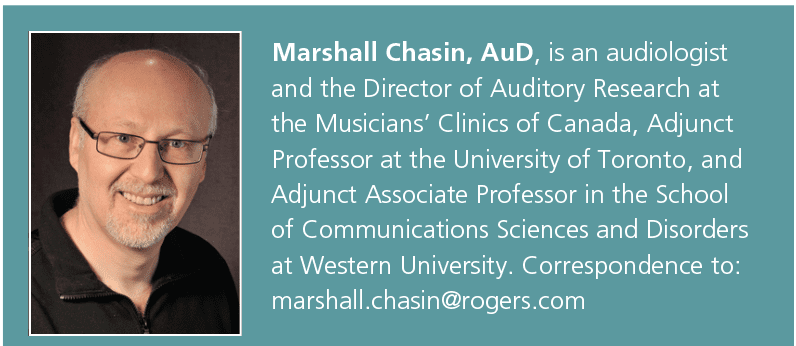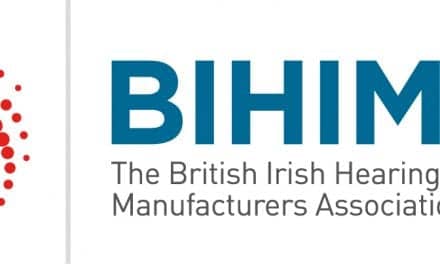Back to Basics | August 2021 Hearing Review
By Marshall Chasin, AuD
In preparation for a book that will be (hopefully) published in the spring of 2022 called Music and Hearing Aids (Plural Publishing, working title), I conducted a literature review of previous research regarding the programming of hearing aids for music.
The research was from many sources, over many years, and with differing research approaches. However, in reviewing everything, it seems that going forward all hearing aids, in addition to their various speech programs, should have three distinct programs for music: 1) Listening to recorded/streamed music; 2) Listening or playing live music; and 3) Listening or playing to “instrumental only” music.
Music Program #1: Listening to Recorded or Streamed Music
Much of the research on this came out of the work by Croghan et al1 over several studies. Among other things, they looked at pre-recorded music that would serve as an input to the hearing aids. Pre-recorded has already been compression limited (CL) once during the recording process to ensure that the dynamic range of the sounds of music are faithfully reproduced, given the more limited dynamic ranges of the MP3 and similar media; then they are subjected again to compression by the hard-of-hearing listeners’ own hearing aids. This double-compression can be problematic. And indeed, these researchers found that linear or slow-acting WDRC would be the best. Their research results had a dependence on the type of music, but a “less is more” approach to hearing aid programming for streamed/recorded music seems reasonable: linear or slight WDRC with slow-acting time constants.
Music Program #2: Listening or Playing Live Music
This music program has been examined by many researchers over the years, including Croghan et al,1 but also researchers out of Vanderbilt (Ricketts et al2) and Cambridge University (Brian Moore, Sara Madsen, and colleagues3,4). When all was said and done, this particular music program might be similar to a speech-in-quiet program, along with the disabling of frequency lowering, noise reduction, and feedback management (see the book for the full explanation).
Issues related to frequency response and frequency bandwidth are more dependent on an individual’s cochlear damage rather than the nature of the input stimulus per se. Similar frequency response and compression settings as a speech-in-quiet program would also be the goal of this live music program.
Music Program #3: Instrumental Music Program
This third music program is based on some work from about a decade ago by Francis Kuk and his colleagues,5 as well as some recent work on frequency lowering—that one octave island of refuge that appeared online in HR in December 2020.6 If the only input to the hearing aid is music and no vocals, then one can impose a linear frequency-lowering algorithm by exactly one octave. This technology was available in the hearing aid industry about a decade ago, but was recommended for bird songs, speech, and for music. However, if it is just restricted to instrumental music, the results can be excellent.
When instrumental music is frequency-lowered linearly by exactly one octave, then the first (and odd-numbered harmonics) line up perfectly with already existing harmonics of the music, and the second and even-numbered harmonics created perfect fifths or thirds in the music. These additional notes (fifths and thirds) were perhaps not what the composer had in mind, but they would not sound dissonant; just different, but acceptable. And like “Music Program #2: Listening or Playing Live Music,” noise reduction and feedback management should be disabled (or at least minimized).
Do we really need three distinct hearing aid programs for music? The literature suggests we do!

Citation for this article: Chasin M. Three distinct hearing aid programs for music? Hearing Review. 2021;28(8):16.
Image: © Carloscastilla | Dreamstime.com
References
- Croghan NBH, Arehart KH, Kates JM. Quality and loudness judgments for music subjected to compression limiting. J Acoust Soc Am. 2012;132(2):1177-1188.
- Ricketts TA, Dittberner AB, Johnson EE. High-frequency amplification and sound quality in listeners with normal through moderate hearing loss. J Speech Lang Hear Res. 2008;51(1):160-172.
- Moore BCJ. Perceptual consequences of cochlear hearing loss and their implications for the design of hearing aids. Ear Hear. 1996;17(2):133-161.
- Madsen SMK, Stone MA, McKinney MF, Fitz K, Moore BCJ. Effects of wide dynamic-range compression on the perceived clarity of individual musical instruments. J Acoust Soc Am. 2015;137(4):1867-1876.
- Kuk F, Korhonen P, Peeters H, Keenan DA. Linear frequency transposition: Extending the audibility of high-frequency information. Hearing Review. 2006;13(11):42-48.
- Chasin M. The problem with frequency transposition and music, Part 2: The one octave example. https://hearingreview.com/hearing-products/hearing-aids/speech-in-noise/frequency-transposition-2. Published December 8, 2020.





